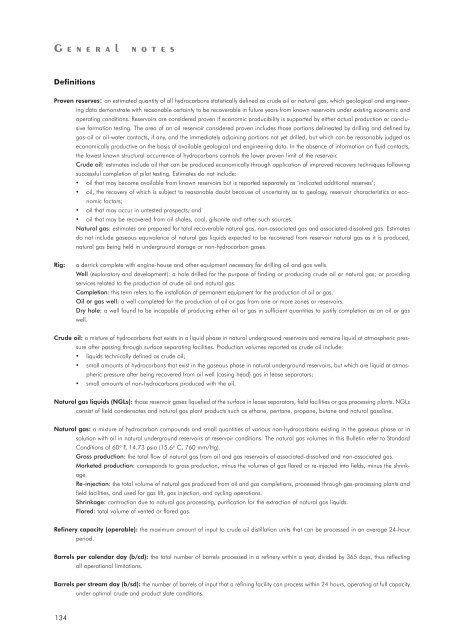Download - Opec
Download - Opec
Download - Opec
Create successful ePaper yourself
Turn your PDF publications into a flip-book with our unique Google optimized e-Paper software.
G e n e r a l n o t e s<br />
Definitions<br />
Proven reserves: an estimated quantity of all hydrocarbons statistically defined as crude oil or natural gas, which geological and engineer-<br />
134<br />
ing data demonstrate with reasonable certainty to be recoverable in future years from known reservoirs under existing economic and<br />
operating conditions. Reservoirs are considered proven if economic producibility is supported by either actual production or conclusive<br />
formation testing. The area of an oil reservoir considered proven includes those portions delineated by drilling and defined by<br />
gas-oil or oil-water contacts, if any, and the immediately adjoining portions not yet drilled, but which can be reasonably judged as<br />
economically productive on the basis of available geological and engineering data. In the absence of information on fluid contacts,<br />
the lowest known structural occurrence of hydrocarbons controls the lower proven limit of the reservoir.<br />
Crude oil: estimates include oil that can be produced economically through application of improved recovery techniques following<br />
successful completion of pilot testing. Estimates do not include:<br />
• oil that may become available from known reservoirs but is reported separately as ‘indicated additional reserves’;<br />
• oil, the recovery of which is subject to reasonable doubt because of uncertainty as to geology, reservoir characteristics or economic<br />
factors;<br />
• oil that may occur in untested prospects; and<br />
• oil that may be recovered from oil shales, coal, gilsonite and other such sources.<br />
Natural gas: estimates are prepared for total recoverable natural gas, non-associated gas and associated-dissolved gas. Estimates<br />
do not include gaseous equivalence of natural gas liquids expected to be recovered from reservoir natural gas as it is produced,<br />
natural gas being held in underground storage or non-hydrocarbon gases.<br />
Rig: a derrick complete with engine-house and other equipment necessary for drilling oil and gas wells.<br />
Well (exploratory and development): a hole drilled for the purpose of finding or producing crude oil or natural gas; or providing<br />
services related to the production of crude oil and natural gas.<br />
Completion: this term refers to the installation of permanent equipment for the production of oil or gas.<br />
Oil or gas well: a well completed for the production of oil or gas from one or more zones or reservoirs.<br />
Dry hole: a well found to be incapable of producing either oil or gas in sufficient quantities to justify completion as an oil or gas<br />
well.<br />
Crude oil: a mixture of hydrocarbons that exists in a liquid phase in natural underground reservoirs and remains liquid at atmospheric pressure<br />
after passing through surface separating facilities. Production volumes reported as crude oil include:<br />
• liquids technically defined as crude oil;<br />
• small amounts of hydrocarbons that exist in the gaseous phase in natural underground reservoirs, but which are liquid at atmospheric<br />
pressure after being recovered from oil well (casing head) gas in lease separators;<br />
• small amounts of non-hydrocarbons produced with the oil.<br />
Natural gas liquids (NGLs): those reservoir gases liquefied at the surface in lease separators, field facilities or gas processing plants. NGLs<br />
consist of field condensates and natural gas plant products such as ethane, pentane, propane, butane and natural gasoline.<br />
Natural gas: a mixture of hydrocarbon compounds and small quantities of various non-hydrocarbons existing in the gaseous phase or in<br />
solution with oil in natural underground reservoirs at reservoir conditions. The natural gas volumes in this Bulletin refer to Standard<br />
Conditions of 60o F, 14.73 psia (15.6o C, 760 mm/Hg).<br />
Gross production: the total flow of natural gas from oil and gas reservoirs of associated-dissolved and non-associated gas.<br />
Marketed production: corresponds to gross production, minus the volumes of gas flared or re-injected into fields, minus the shrinkage.<br />
Re-injection: the total volume of natural gas produced from oil and gas completions, processed through gas-processing plants and<br />
field facilities, and used for gas lift, gas injection, and cycling operations.<br />
Shrinkage: contraction due to natural gas processing, purification for the extraction of natural gas liquids.<br />
Flared: total volume of vented or flared gas.<br />
Refinery capacity (operable): the maximum amount of input to crude oil distillation units that can be processed in an average 24-hour<br />
period.<br />
Barrels per calendar day (b/cd): the total number of barrels processed in a refinery within a year, divided by 365 days, thus reflecting<br />
all operational limitations.<br />
Barrels per stream day (b/sd): the number of barrels of input that a refining facility can process within 24 hours, operating at full capacity<br />
under optimal crude and product slate conditions.
















